There is no doubt that life is good in Logroño. The capital of La Rioja is one of the Spanish cities where its inhabitants and visitors know how to enjoy life. Its excellent gastronomy and Rioja wine -of course- are the best companions for a stroll through the city's pedestrian streets and parks.
Although Logroño has many attractions, we have compiled a list of the twelve essential visits that everyone who comes to the capital of La Rioja should take into account.
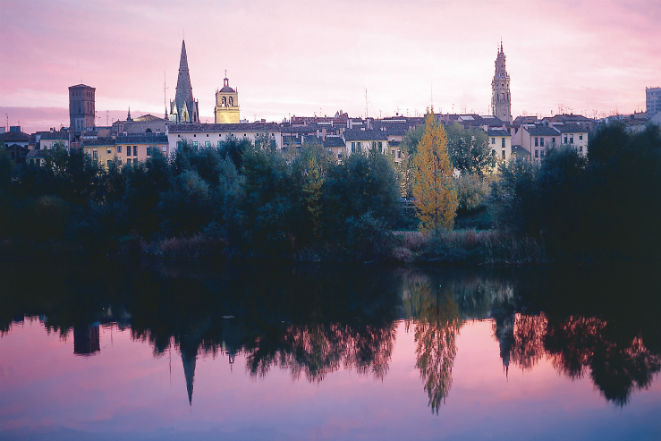
The old quarter of Logroño reflected in the river Ebro. Courtesy of: La Rioja Tourism
1. LAUREL STREET. THE ROUTE OF THE ELEPHANTS
If there is a well-known street in Logroño, it is Calle del Laurel, lined with bars and one of the most famous drinking areas in Spain. There are some 60 establishments where you can sample the succulent Riojan gastronomy based on pinchos such as migas, matrimonios, rotos or champis, among many others.
A curiosity: the name comes from the fact that, in the past, the women who worked as prostitutes lived in this street, and so that the clients would know which one was available, they hung a branch of laurel on their balconies. In times of crisis, the whole street was full of balconies with laurel, which gave rise to its name. It is also popularly known as "The Elephant's Path", due to the possibility of getting out on your trunk and on all fours like these pachyderms.

Laurel Street. Courtesy of: La Rioja Tourism
2. CO-CATHEDRAL OF SANTA MARIA LA REDONDA
One of the most curious buildings in Logroño is the co-cathedral of Santa María la Redonda. Many will wonder why it is called this when it does not have this shape. The answer is that it was built during the 16th century on the site of a Romanesque church that was indeed round. It is also curious that its towers are known as the twins when one is a couple of metres higher than the other. The twins are icons of classical Riojan architecture. They were modelled on the tower of the church of Santo Tomás de Haro and can also be found in other towns such as Santo Domingo de la Calzada or Briones.
The co-cathedral of Santa María la Redonda is built in a marshy area a short distance from the river Ebro. The foundations were made with vine shoots, the stems of the vines, as they do not rot with humidity and therefore distribute the loads well and absorb the settlements.
A painting attributed to Michelangelo, The Calvary, who painted this panel for his friend Vitoria Colonna, is preserved here.
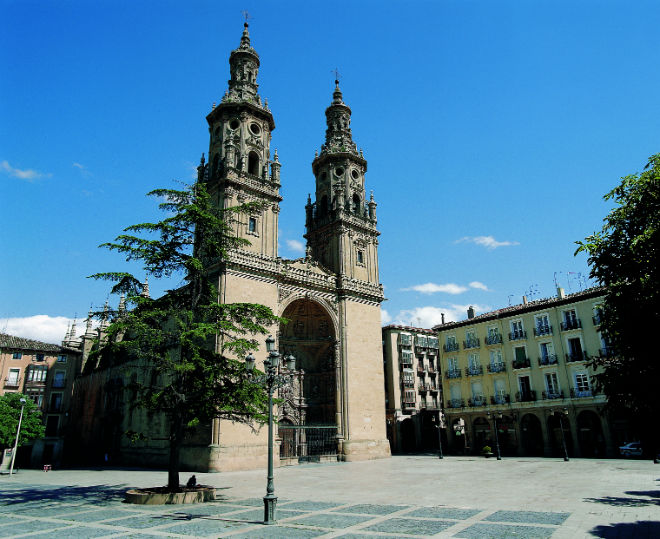 Co-cathedral of Santa María La Redonda. Courtesy of: La Rioja Tourism
Co-cathedral of Santa María La Redonda. Courtesy of: La Rioja Tourism
3. LOGROÑO AND ITS TOWN COUNCILS
Both the old and the new Logroño Town Hall are worth a visit.
The current building was designed by the prestigious Spanish architect Rafael Moneo and clad in Salamanca sandstone, while the old Town Hall was located in the 16th century palace of Los Chapiteles, which was the Town Hall for 115 years until 1980. It is currently the headquarters of the Instituto de Estudios Riojanos.
4. MODERN COFFEE
One of the most emblematic places in Logroño is the Café Moderno, located in Calle Francisco Martínez Zaporta. Founded in 1916, several generations have been at the helm of this family business, which has been frequented by a large number of artists. A curiosity: it has its own hymn, "Fibra de pájaro", by Daniel Bravo, which is played every Friday and Saturday night.
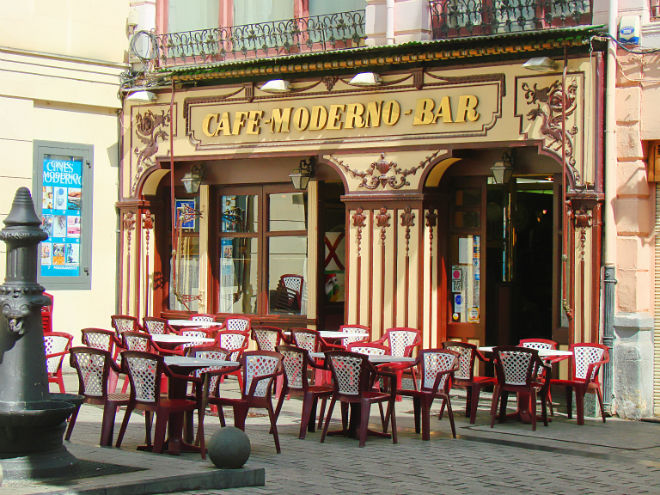 Café Moderno. Author: Abenteuer-elternzeit.de
Café Moderno. Author: Abenteuer-elternzeit.de
5. THE SPUR
The best-known green area in the city is the Espolón park, which dates back to the early 19th century. At that time, any public square outside the city walls was called an espolón.
Here you will find the equestrian statue of General Baldomero Espartero, who was married to a Logroño woman, Jacinta Martínez de Sicilia. They were a much-loved couple by the inhabitants of Logroño, and after retiring from politics, they went to live in what is now the Museum of La Rioja, located in the Plaza San Agustín.
There is also La Concha del Espolón, one of the most common venues for concerts and where, during the festivities of San Mateo, which take place in September, the offering of the first grape juice of the year to the Virgin is made.
6. WINE CELLARS IN RUAVIEJA
The old quarter of Logroño is full of "calados", which is the name given in La Rioja to the cellars that used to be under the houses.
Some of them stand out for their great size, such as the 16th-century San Gregorio fretwork, which is 30 metres long and has a barrel vault. Another impressive feature is the openwork of the old palace of the Yanguas family, today the Centre of Culture of La Rioja. As a curiosity, a municipal ordinance from 1583 prohibited the passage of horseshoed carriages through the Ruavieja so as not to disturb the rest of the wines resting in the cellars.
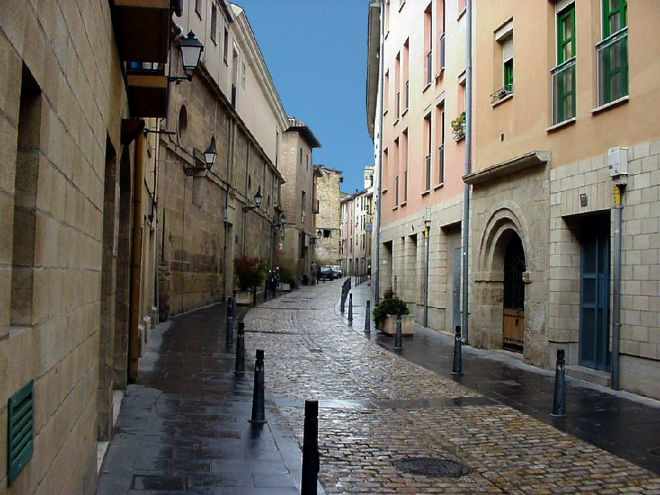 Calle Ruavieja, under which there are many fretworks. Author: Termometroturistico.es
Calle Ruavieja, under which there are many fretworks. Author: Termometroturistico.es
7. THE PARLIAMENT
On Calle Marqués de San Nicolás is the Parliament of La Rioja, which was formerly the old Convent of La Merced (the 17th century Baroque façade still remains) and the home of the Mercedarian order until the disentailment of Mendizábal in 1835. It was later a tobacco factory.
 Parliament of La Rioja. Author: Zarateman
Parliament of La Rioja. Author: Zarateman
8. IMPERIAL CHURCH OF SANTA MARIA DE PALACIO
The next unmissable visit in Logroño is also on Calle Marqués de San Nicolás. This is the Imperial Church of Santa María de Palacio, whose oldest remains were built between the 12th and 13th centuries. The octagonal spire that crowns it is an element that characterises the skyline of Logroño.
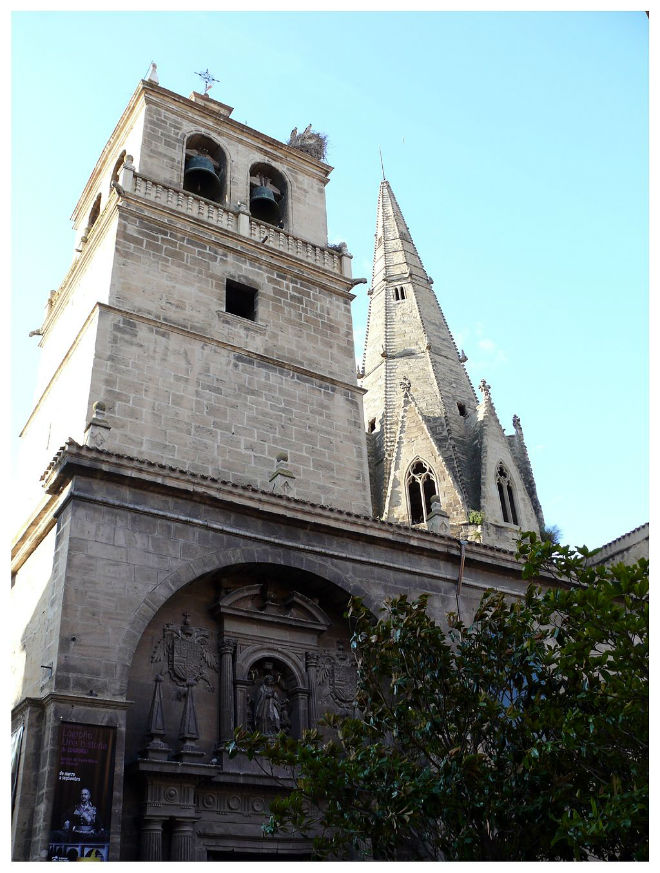 Imperial Church of Santa María de Palacio
Imperial Church of Santa María de Palacio
9. THE CHURCH OF SANTIAGO
The Church of Santiago is an obligatory stop for all pilgrims as Logroño is closely linked to the Pilgrim's Way to Santiago. Inside is the Virgen de la Esperanza, patron saint of the city, and the crypt of the condemned.
The church played a special role during the great siege of 1521 because the people of Logroño took refuge within its walls. Near this church is the Plaza de la Oca, called by the pilgrims themselves the game of the goose. It is an allegory of the French Pilgrim's Route to Santiago de Compostela, in which each of the stops on the Pilgrims' Route to Santiago de Compostela appears.
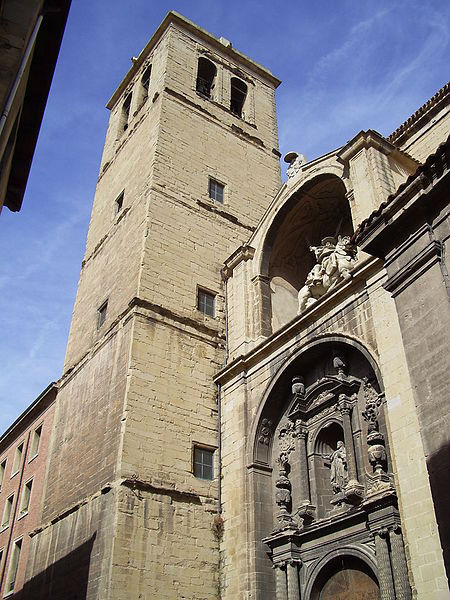 Church of Santiago. Author: Jynus
Church of Santiago. Author: Jynus
10. THE STONE BRIDGE
The stone bridge is one of the symbols of the city. In fact, the Logroño coat of arms features this bridge over the river Ebro with its three defence towers. It is also called the Bridge of San Juan de Ortega, in reference to the chapel that existed on its left bank (in honour of the saint who is traditionally believed to have built the original bridge).
11. THE IRON BRIDGE
Built by the company Maquinista Terrestre y Marítima de Barcelona, according to the project signed in July 1881 by the engineer Fermín Manso de Zúñiga, it was opened to the public in December 1882, although it was definitively completed in the middle of the following year. This project was supported at all times by the President of the Government Práxedes Mateo Sagasta.
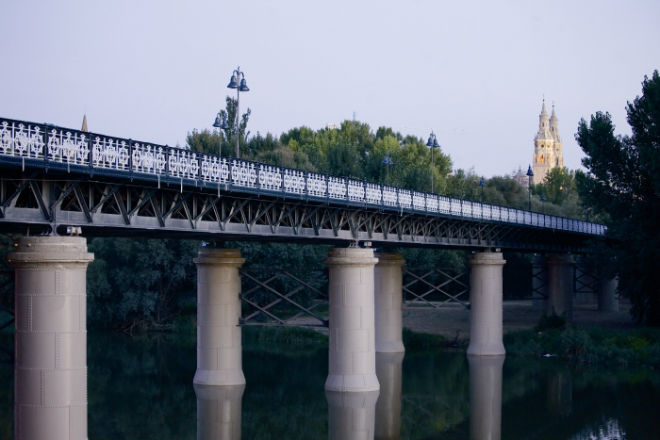 Iron Bridge. Author: Larioja.org
Iron Bridge. Author: Larioja.org
12. VISIT TO THE WINERIES VIVANCO AND MUSEUM OF WINE CULTURE
Finally, we could not finish a route around Logroño without visiting some of its best-known wineries. Half an hour's drive from the capital of La Rioja is Vivanco (Carretera Nacional 232, 26330. Briones), a benchmark for wine in La Rioja.
Not to be missed is the Museum Vivanco of Wine Culture, which occupies a surface area of 4,000 square metres and includes 5 permanent exhibition rooms, a temporary exhibition room and, outside, the Garden of Bacchus, a collection of vines with more than 220 varieties from all over the world.
 Winery and Museum of the wine tourism complex Vivanco
Winery and Museum of the wine tourism complex Vivanco
Logroño has many more charming spots, can you share them with us?







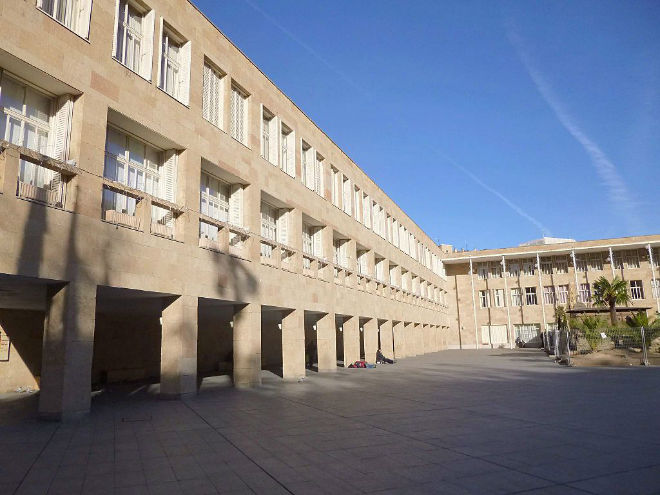
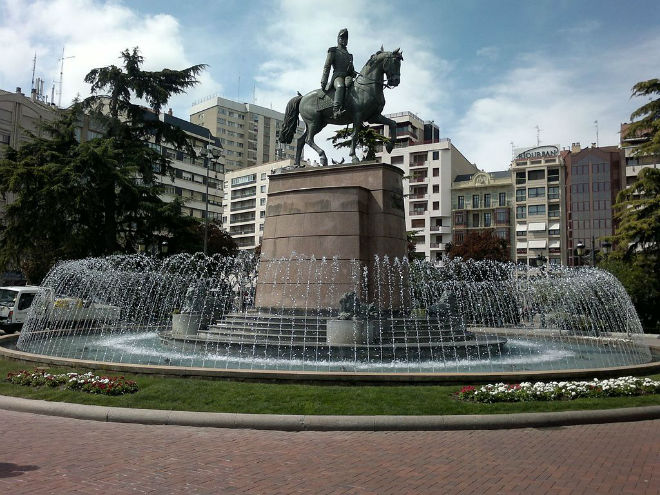
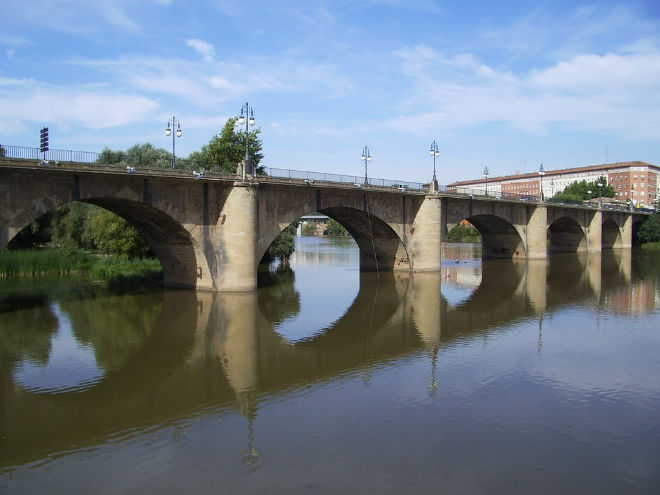
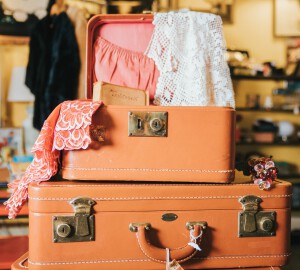
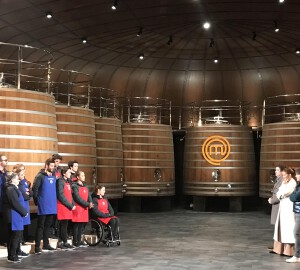
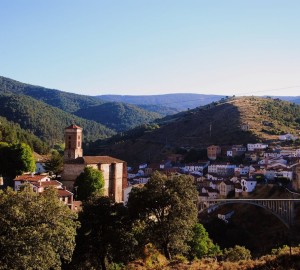







Wow! I can't wait to go, yuju! I loved the town halls, what a baroque style!
The bridge that appears on the Logroño coat of arms is not the stone bridge in the photo but an earlier one that was in the same location as the current one. In fact, this stone bridge, contrary to popular belief, is slightly later than the Sagasta iron bridge.
Thank you very much for your appreciation.
Greetings, logroñesa 🙂
we would like to know which restaurants are likely to be open for dinner on new year's eve 2016 in the city of logroño,thank you.
Hello Esme,
We share with you a list of restaurants in Logroño where you can get to know the gastronomic offer of each one: https://lariojaturismo.com/comunidad/larioja/comer-y-beber?default;rdf:type=gastro&gastro;harmonise:city@@@harmonise:name=logro%C3%B1o
Best regards!
La Rioja, good land, good people. Greetings from a Tudelano from Tarazona ....
The truth is that Logroño is one of the most beautiful cities in this country. It has an important gastronomic culture and it is definitely worth visiting and tasting its wines.